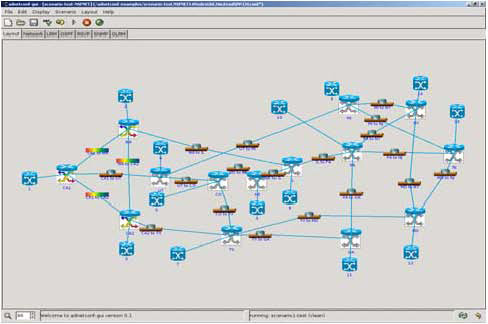Tech. Session 3: PCE
Friday 6, June 2008 10:00-11:40
Chair: Young Lee, Huawei
T3-1 "Inter-Carrier PCE-Based Path Computation in Keihanna Interoperablity Project"
Tomonori Takeda, NTT, Eiji Oki, NTT, Yohei Iizawa, NEC, Itaru Nishioka, NEC, Machiko Asaie, Hitachi, Kazuhiro Kusama, Hitachi, Shuichi Okamoto, KDDI R&D, and Tomohiro Otani, KDDI R&D, Japan
 This presentation reports that an interoperability test on PCEP (Path Computation Element communication Protocol) was performed among four vendors/carriers in Keihanna Interoperablity Project. Basic functions of PCEP in a single-PCE environment were successfully confirmed referring to [1]. This presentation also describes our goal, which is inter-carrier PCE-based diverse path computation shown in Figure 1. The key extensions to achieve inter-carrier diverse path computation preserving confidentiality are Path Key ID and Exclusive Route Objects [2][3]. This presentation reports that an interoperability test on PCEP (Path Computation Element communication Protocol) was performed among four vendors/carriers in Keihanna Interoperablity Project. Basic functions of PCEP in a single-PCE environment were successfully confirmed referring to [1]. This presentation also describes our goal, which is inter-carrier PCE-based diverse path computation shown in Figure 1. The key extensions to achieve inter-carrier diverse path computation preserving confidentiality are Path Key ID and Exclusive Route Objects [2][3].

Figure 1: Inter-Carrier Diverse PCE-based Path Computation
[1] JP. Vasseur and JL. Le Roux (Ed.), gPath Computation Element (PCE) Communication Protocol (PCEP)", IETF draft, draft-ietf-pce-pcep-09.txt, Nov. 2007.
[2] Rich Bradford, JP Vasseur, and A. Farrel, gPreserving Topology Confidentiality in Inter-Domain Path Computation Using a Key-Based Mechanism ", IETF draft, draft-ietf-pce-path-key-01.txt, Sep. 2007.
[3] E. Oki and A. Farrel, efExtensions to the Path Computation Element Communication Protocol (PCEP) for Route Exclusionsff, IETF draft, draft-ietf-pce-pcep-xro-02.txt, Sep. 2007.

Biography: Tomonori Takeda received the B.E. and M.E. degrees in Electronics, Information and Communication Engineering from Waseda University, Tokyo. Currently, he is with NTT Network Service Systems Laboratories, where his work is focused on IP optical network architecture and related protocols. He has been involved in standardization activities, and co-chairs the Layer 1 Virtual Private Network (L1VPN) working group in the IETF.
T3-2 "End-to-End path routing with PCEs in multi-domain GMPLS networks"
Itaru Nishioka, Shinya Ishida, Yohei Iizawa, NEC, Japan
 This presentation provides our prototype of the multi-domain PCE-based path routing system, after reviewing the comparison of multi-domain routing models that have been being discussed in standard bodies. This presentation provides our prototype of the multi-domain PCE-based path routing system, after reviewing the comparison of multi-domain routing models that have been being discussed in standard bodies.
There are three available routing models, the per-domain routing, the ASON hierarchical routing, and the PCE-based routing, for the ASON/GMPLS multi-domain networks. We compare these three routing models in terms of path computation capabilities, on-line multiple path planning capability and inter-domain confidentiality [1]. According to our analyses, the PCE-based routing and the ASON hierarchical routing models have rich capabilities enough for multi-domain ASON/GMPLS network operation, while the per-domain routing does not provide much capabilities. One of the significant issues left for the ASON hierarchical routing model is an appropriate abstraction mechanism which strongly affects the path computation capabilities and inter-domain confidentiality. In addition to the sufficient path computation capabilities, the PCE-based routing model offers the on-line bulk optimization for multiple requests. Therefore, we concluded that the PCE-based routing is the most suitable for path routing in the multi-domain ASON/GMPLS networks.
In the rest of our presentation, our PCE-based path routing system with newly-developed diverse path computation algorithm is discussed.
The key features of this system are inter-PCE path computation capabilities for the shortest path and end-to-end diverse path by BRPC (Backward Recursive PCE-based Computation). BRPC [2] is a path computation procedure that computes the shortest path along a chain of PCEs, by exchanging summarized TE information called VSPT (Virtual Shortest Path Tree). Ref. [2] also mentions applicability of BRPC to the diverse end-to-end path computation, but the detail procedure is not described. In the presentation, we demonstrate the usage of BRPC for the end-to-end diverse path computation. In addition, our PCE has the optimized path computation algorithm for BRPC procedure. Diverse path computation complexity using BRPC is generally proportional to the square of the number of border nodes between domains. Our developed algorithm can reduce it from O(N^2) to O(N), and contribute to improve computation time dramatically. The detail of path computation algorithm is also provided in iPOP2008.
Acknowledgment:
This work was partly supported by National institute of Information and Communications of Technology Japan.
[1] I. Nishioka, Y. Iizawa, S. Araki, "Multi-domain ASON/GMPLS network operation: current status and future evolution," Proceedings of SPIE Vol. 6784, 67840T (2007).
[2] JP. Vasseur, et. al., gA Backward Recursive PCE-based Computation (BRPC) procedure to compute shortest inter-domain Traffic Engineering Label Switched Paths,h IETF Internet-Draft draft-ietf-pce-brpc-07.txt (Work in progress), Feb. 2008.

Biography: Itaru Nishioka received the B.E. and M.E. degrees in communications engineering from Osaka University, Osaka, Japan, in 1998 and 2000, respectively. In 2000, he joined NEC Corporation, Kawasaki, Japan, where he has been engaged in the research and development of optical networking systems and the design of its control/management architecture. He is a member of IEEE.
T3-3 "Path Computation Issues and Solutions in Wavelength Switched Optical Networks (WSON)"
Young Lee, Huawei, USA, Greg Bernstein, Grotto Networks, USA, Daniel King, Aria-Networks, UK
 The use of GMPLS-based and PCE-based path computation for Wavelength Switched Optical Networks is considered in this paper with respect to the following key issues: The use of GMPLS-based and PCE-based path computation for Wavelength Switched Optical Networks is considered in this paper with respect to the following key issues:
- Types of path computation and constraints in WSON
- Path computation architecture choices
- Information requirements for WSON path computation
- Information dissemination strategies
Unique to lightpath computation in WSON is routing and wavelength assignment (RWA). In a WSON without wavelength converters two lightpaths that share a common fiber link can not be assigned the same wavelength. This constraint is referred to as gwavelength continuityh constraint. From the perspective of a carrier path computation functions should support both sequential path computation in which one path computation is done at a time and concurrent path computation in which a set of paths are computed optimally. Distributed path computation may not be suitable for concurrent path computation when the set of paths to be computed have different head-end nodes. This scenario occurs when computing shared backup path computation for a set of independent working paths.
There are a number of options from the path computation architectural and protocol perspective. These vary in the number of path computation elements involved with the computation, the amount of information distributed via routing protocols or other mechanisms, and the amount of information carried via signaling and the amount of processing at each node along the signaling path.
Understanding information requirements for control plane to be able to compute lightpath is one of the key issues in WSON path computation. WSON nodes characteristics and link characteristics must be made known to control plane path computation module. As WSON nodes are typically mixture of fully wavelength convertible switches (e.g., OXC), partial wavelength convertible switches or no wavelength convertible switches (e.g., PXC), these node characteristics and its port capability are required in lightpath computation function. As port connectivity in ROADM is typically asymmetric while that in OXC is symmetric, port connectivity information is required in lightpath computation function. Wavelength availability on each fiber link is also key information for path computation function to be able to provision a lightpath.
WSON path computation information can be disseminated either via flooding (e.g., OSPF-TE) or via a direct management interface. However, scalability and convergence time has been a concern with the flooding mechanism and management interfaces are not suitable for highly dynamic information. We give compact representation of WSON information and discuss a possible alternative to flooding.

Biography: Young is currently Principal Technologist at Advance Technology Division, Huawei Technologies USA Research Center, Plano, Texas. He is leading optical transport control plane technology research and development.? His research interest includes distributed path computation architecture, multi-layer traffic engineering methodology, and network optimization modeling and new concept development in optical control plane signaling and routing. ?
Prior to joining to Huawei Technologies, Young was a co-founder and a Principal Architect at Ceterus Networks (2001-2005) where he developed topology discovery protocol and control plane architecture for optical transport core product. Prior to joining to Ceterus Networks, Young was Principal Technical Staff Member at AT&T/Bell Labs in Middletown/Holmdel, New Jersey. ?At AT&T Labs (1996-2000), he was responsible for core IP/MPLS network architecture evolution and AT&T End-to-end architecture planning. He also involved voice/data convergence architecture planning and evolution. At Bell Labs (1987-1995), Young was responsible for developing dynamic routing schemes and traffic network management control and measurement development. He is currently active in IETF PCE and CCAMP WGs and is a co-author of RFC 3214. He holds several patents in the area of dynamic routing and switching technology and several patents pending in optical networking.
Young Lee received B.A. degree in Applied Mathematics from the University of California at Berkeley in 1986, M.S. degree in Operations Research from Stanford University, Stanford, CA, in 1987, and Ph.D. degree in Decision Sciences and Engineering Systems from Rensselaer Polytechnic Institute, Troy, NY, in 1996. He is a member of IEEE and Alpha Phi Mu honor society.
T3-4 "Deploying Advanced Path Computation Technologies for Optical Transport Networks"
Daniel King, Aria Networks, UK, Takehiro Tsuritani, KDDI R&D, Japan
Currently, most optical transport network nodes are fairly static and services are pre-planned and deployed manually. Adding new services requires significant planning and sub-optimal deployment of services wastes resources, and in extreme cases, can cause network instability or network failures. In this proposal, we highlight the experiences of deploying and using advanced path computation technologies to facilitate dynamic, flexible and optimal management of optical transport networks.
When computing paths across an optical transport network, the path computation technology should consider more than just routing constraints to provide optimal paths and facilitate service deployment. These extended constraints include: lightpath route parameters, wavelength continuity, attenuation (power loss), amplified spontaneous emission (ASE), chromatic dispersion (CD), polarization mode dispersion (PMD), optical fiber non-linear phase shift (NLPS) and filter concatenation effect.
The overall architecture of the optical path computation solution developed includes a path computation engine referred to as an optical path computation element (PCE), and a network management system. The optical PCE developed can consider a number of advanced optical constraints for path computation, as well as supporting the conventional network constraints, such as share risk link groups (SRLG), the number of hops and a metric (cost) in addition to the physical impairments and the wavelength continuity constraints. These constraints can be independently weighted based on a specific service type and simultaneously considered for the path computation. Once the path or set of paths are computed the results are handed back to the network management system for activation in the optical network.
Our talk will cover the requirements for deploying and operating advanced optical networks. We will highlight how PCE technologies, in cooperation with network management systems can help with the deployment, operation of these advanced optical networks. The speaker will also outline successfully verified results of effective and fast optical-path computation using a PCE, while being able to consider a wide range of optical and service constraints.

Tech. Session 4: GELS
Friday 6, June 2008 13:00-14:15
Chair: Don Fedyk, Nortel
T4-1 "Experimenting with GMPLS to control a PBB-TE network"
Benoit Tremblay, Attila Takacs, Howard Green, Ericsson Research, Canada
 Ethernet has become over the years the undisputed leading Local Area Network (LAN) technology. This achievement stems from the intrinsic characteristics of the technology: simple, cheap, easy to manage, and backward compatible. A range of enhancements in terms of scalability, manageability, Operation and Maintenance (OAM), resilience, Quality of Service (QoS), and synchronization are currently being discussed, studied and standardized by IEEE, IETF, ITU-T and MEF, to prepare native Ethernet for Carrier Class deployment. Ethernet has become over the years the undisputed leading Local Area Network (LAN) technology. This achievement stems from the intrinsic characteristics of the technology: simple, cheap, easy to manage, and backward compatible. A range of enhancements in terms of scalability, manageability, Operation and Maintenance (OAM), resilience, Quality of Service (QoS), and synchronization are currently being discussed, studied and standardized by IEEE, IETF, ITU-T and MEF, to prepare native Ethernet for Carrier Class deployment.
These will move the Ethernet technology from the ps-cl paradigm towards a ps-co one making it suitable for converging the transport of High Speed Internet (HSI), Internet Protocol TV (IPTV), Business Communication and Radio Access Network (RAN) backhauling services.
The basic control plane provided by Ethernet relies on the spanning tree protocols and do not fulfill the traffic engineering requirements of transport networks. Moreover STPs do not assures recovery times in accordance with the stringent requirement imposed by critical applications. GMPLS has proven to be an efficient mechanism to provide traffic engineering and to automate the operations and configuration of TDM (SONET/SDH and G.709) networks. Extensions to GMPLS to support Ethernet transport networks, will provide similar mechanisms for control as for other transport technologies (i.e. optical networks). The work on the GMPLS extensions is currently in progress at IETF CCAMP and known as GMPLS controlled Ethernet Label Switching (GELS).
Ericsson has implemented an experimental test-bed of the emerging PBB-TE (IEEE 802.1Qay) network, applying an extended GMPLS control plane. This test-bed is used to validate the emerging PBB-TE data plane as well as to validate the necessary extensions to GMPLS. Backed with the implementation experience, we provide feedback to the work in progress in the related standardization bodies. The test-bed demonstrates traffic management, OAM features, restoration and sub-50 ms protection switching.
In this presentation, we will describe IEEE PBB-TE data plane and GMPLS control plane aspects of the test-bed and present results from the experimentation. The presentation will conclude on further work to be done to validate and if necessary refine specifications to provide point-to-multipoint services.

Biography: Benoit Tremblay collaborates with Ericsson for more than 10 years. He has been involved in developing distributed servers for mobile networks. He joined Ericsson Research in 2002 where he focused on establishing experimental systems for the IP edge, access and broadband networks. He graduated in Mathematics with specialization in Computer Science from the Universite du Quebec a Montreal in 1986 and completed a Master Degree in 1988. His current topics of interest are broadband network and packet systems.
T4-2 "GMPLS control of PBB-TE"
Don Fedyk, Nortel, USA
 Target Audience: Who should attend this presentation - Service Providers Target Audience: Who should attend this presentation - Service Providers
Description:
This talk covers an important recent development in Ethernet technology, namely Provider Backbone Bridges -Traffic Engineering (PBB-TE, known within IEEE as 802.1Qay) and how GMPLS can be used effectively as a control plane solution.
Ethernet has been evolving to allow scalable provider backbones. PBB introduced the concept of recursion and VLAN partitioning to support many virtual customer networks with great scalability and improved security. PBB-TE is a new technology that has removed the traditional Ethernet control plane and replaced it with a simple configuration model. The OAM advantages of Ethernet and protection schemes are adopted by PBB-TE.
PBB-TE is a connection oriented technology and is thereby very suitable for control by GMPLS. This paper looks at the proposals to control PBB-TE with GMPLS and the current developments regarding GMPLS and Ethernet protocols.

Biography: Don Fedyk (dwfedyk@nortel.com) is a Senior Technical Advisor at Nortel. Don is an authority on Routing System design for both connectionless and path oriented routing. Don is a contributor to several GMPLS drafts and an active follower of several the IETF Working groups including CCAMP, MPLS, Routing Area WG. Recently Don has been focused on application of GMPLS and Link State protocol to Provider Ethernet in the IEEE. Don received his B.S. and M.S. degrees in Electrical Engineering from the University of Waterloo, Waterloo Ontario, Canada.
T4-3 "Example of a GMPLS control plane interconnected with an Ethernet data plane in a rack-mounted prototype"
A. Dupas, R. Boislaigue, C. Cosse-maniere, G.Post, M. Lorret, Alcatel-lucent Bell-labs, France
 Network concept. Network concept.
Many studies are focusing on the concept of Label Switch Path (LSP) at the layer 2 level. As GMPLS is a promising control plane for distributed and scalable networks, different alternatives for the label format are still considered. One solution to transport the control label is to use the Ethernet frame format, and thus mixing the advantages of a low cost Ethernet data plane and the robustness of a GMPLS control plane. This paper presents a possible implementation of an Ethernet data plane directly interconnected with a GMPLS control plane. We experimentally demonstrate the automation of bidirectional LSP establishment for native L2 flows from server to client and the Explicit Label Control of the client label with tunneling feature.

Experimental validation.
The prototype, built in the frame of European project IST/NOBEL phase 2, is composed of three nodes, linked with standard fibers. Each node is equipped with 1GE and 10GE interfaces, and is connected with one GMPLS controller, which performs the management of the node and implements the OSPF-TE and RSVP-TE modules. Each node is connected to a video client or server and real time video traffic is sent over the network within the established bidirectional LSP to validate the routing and switching features. The switching operation is realized in a FPGA (Field Programmable Gate Array) by a non-blocking architecture with a maximum throughput of 16 Gb/s. For each incoming frame, the first or two first labels can be processed and compared to the input of an internal Look Up Table. Depending of its content, the switch performs the frame forwarding with label operation like push, pop, swap, or a combination of these operations (like swap + push). We observed the behavior of the node by sending in band GMPLS control frames with real data traffic. At full load, no loss has been measured on the GMPLS control frames, which have the highest priority within the switch. Due to a parallel processing and a non-blocking architecture, the node latency is low (~5 Ês) and compatible with GMPLS carrier grade network requirements. This concept is attractive for future extended Ethernet-based transport networks and can be adapted to any layer 2 technologies.

Biography: Arnaud Dupas works as R&D Engineer at Alcatel-Lucent Bell-labs in Nozay, France. He is involved in the networking research domain and more particularly in hardware FPGA prototyping of advanced network functions and GMPLS protocols. He participated to several European projects like IST/NOBEL 2, IST/DAVID and ATCS/KEOPS.
Prior to joining Alcatel CIT in 1999, Arnaud Dupas worked as PhD student in the National Research Center of France Telecom, CNET, Lannion, France on new optical functions and its applications for WDM Networks. He received in 1996 the Eng. Dipl. in physics from the Institut National des Sciences Appliquees, INSA, Rennes, France.
Tech. Session 5: OAM
Friday 6, June 2008 14:30-16:10
Chair: Adrian Farrel, Old Dog
T5-1 "Design, implementation and validation within ADRENALINE® testbed of a Path Computation Element for Wavelength Switched Optical Networks"
Ramon Casellas, Ricardo Martinez, Raul Munoz, CTTC -Centre Tecnologic de Telecomunicacions de Catalunya, Spain
 The Path Computation Element (PCE) working group has defined the architecture [1] and a communications protocol (PCEP) [2] so entities within a GMPLS network -- or Path Computation Clients (PCCs) -- may request the computation of an explicitly routed path given a set of constraints. Such architecture is motivated by the complexity of path computation in large, multi-domain, multi-region, or multi-layer networks, which may eventually require dedicated computational resources and cooperation between network domains. The new architecture raises challenges and new issues that need to be addressed regarding the feasibility and applicability of the PCE in general, and in GMPLS controlled wavelength switched optical networks (WSONs) in particular. The Path Computation Element (PCE) working group has defined the architecture [1] and a communications protocol (PCEP) [2] so entities within a GMPLS network -- or Path Computation Clients (PCCs) -- may request the computation of an explicitly routed path given a set of constraints. Such architecture is motivated by the complexity of path computation in large, multi-domain, multi-region, or multi-layer networks, which may eventually require dedicated computational resources and cooperation between network domains. The new architecture raises challenges and new issues that need to be addressed regarding the feasibility and applicability of the PCE in general, and in GMPLS controlled wavelength switched optical networks (WSONs) in particular.
In this presentation, an overview of the design and implementation of a PCE for WSONs is given, covering both the functional and protocol architectures and its integration in a GMPLS network. In this context, the following aspects are detailed: first, the deployed extensions for WSONs (either proprietary and / or proposed by relevant state of art and normalization efforts at the IETF CCAMP and PCE WGs), such as bitmap-based OSPF-TE wavelength information dissemination [3][4] or specific PCEP extensions for optical networks [5]; second, the design criteria for the actual gpath computation engineh, which drives the constrained path computation, including the implemented modular algorithm application programming interface (API) using shared libraries and, finally, the preferred synchronization mechanism with the Traffic Engineering (TE) database, by means of deploying PCE node(s) collocated in a Network Element and tied to an OSPF-TE routing controller. The approach uses stateful inspection of TE Link SubTLVs contained within OSPF-TE LS updates and, in consequence, passively reusing the OSPF-TE dissemination mechanism.
In order to validate and assess the applicability of the implemented PCE on real production networks, an outline of carried-out experimentations and selected numerical results are provided, obtaining simple yet meaningful performance indicators such as path computation times and LSP setup delays using a 14-node NSFNET network topology (fig.1) with a GMPLS control plane using CTTCfs ADRENALINER testbed (fig. 2), when compared to more traditional distributed source-based path computation. Finally, the presentation concludes with an overview of missing features and extensions, the assessment of proposed redundancy mechanisms, and ongoing work related to exhaustive scalability measurements.

Figure 1. 14-node NSFNET topology

Figure 2. ADRENALINE GMPLS controlled WSON testbed References
[1] A. Farrel et al. gA Path Computation Element (PCE)-Based Architectureh, RFC4655.
[2] J.P. Vasseur et al. gPath Computation Element (PCE) Communication Protocol (PCEP)h draft-ietf-pce-pcep, work in progress.
[3] G. Bernstein et al. WSON framework draft-bernstein-ccamp-wavelength-switched, work in progress.
[4] R. Martinez, R. Munoz, R. Casellas, J. Comellas, G. Junyent, Experimental Shared Path Protection Algorithms in Distributed All-Optical GMPLS-based Networks, 6th International Workshop on the Design of Reliable Communication Networks (DRCN2007), La Rochelle (France). October 8-10 2007.
[5] Y.Lee et al. PCE and WSON draft-lee-pce-wson-routing-wavelength, work in progress.

Biography: Ramon Casellas (Barcelona, 1975) graduated in Telecommunications Engineering in 1999 both from Technical University of Catalonia (UPC, Barcelona) and from the Ecole Nationale Superieure des Telecommunications (ENST, Paris). He obtained his PhD degree in Telecommunications in 2002 (ENST, Paris) funded by a CTI project with France Telecom Research and Development. He has worked as an undergraduate researcher at France Telecom Research and Development - FT R&D formerly known as Centre Nationale d'Etudes des Telecommunications (CNET) and British Telecom Labs (Ipswich). In 2002, he joined the Networks and Computer Science Department at the ENST as an Associate Professor. In March 2006, he joined the CTTC Optical Networking Area, and he is currently Research Associate and CTTC ADRENALINE Testbed coordinator. His research interest areas include GMPLS architecture, Traffic Engineering and Distributed control schemes.
T5-2 "GMPLS OAM Tool Kit"
Zafar Ali, Cisco Systems, USA, T. Otani, KDDI R&D, Japan, Roberto Cassata, Cisco Systems, USA, Marco Anisetti, Valerio Bellandi, Ernesto Damiani, Francesco Diana, Umberto Raimondi, University of Milan, Italy
GMPLS OAM has been recently added to IETF CCAMP Charter and the idea is to evaluate GMPLS OAM requirements and device required solutions. This presentation starts by providing a summary of GMPLS OAM requirement and highlighting the solution gaps.
GMPLS OAM solutions can be broadly divided into technology based or technology independent solutions. Specifically, if OAM mechanisms provided by the underlying data plan technology, we call such solutions as technology based solutions. E.g., G.709 addresses the problem of trace routing in DWDM network. However, G.709 OAM mechanisms are only applicable to OEO (Optical-Electrical-Optical) capable node. In such cases we need technology independent solutions to address GMPLS OAM requirements.
This talk presents both technology based and technology independent solutions as a tool kit available to address GMPLS OAM requirement. It also provides applicability statement for each solution. The later part of the presentation is focused on technology independent solutions. As mentioned above, technology independent solutions are to fill gaps in technology based OAM solution space; in particular it addresses GMPLS OAM functionality in optical networks with wavelength routers, ROADMs nodes, etc. with no OEO conversion capability. The presentation outlines how control plan mechanism based on Link Management Protocol (LMP) [RFC4204] and RSVP-TE [RFC3209], [RFC3473] can be used to provide technology independent GMPLS OAM solutions.
The presentation also highlights physical quality measurement along a GMPLS LSP as another important aspect of GMPLS OAM. Specifically, it details why for successful fault detection on a light-path, the fault isolation mechanism must be aware of all physical evidence (consisting of optical measurements such as signal power, OSNR, OCM (Optical Channel Monitor), etc.) that have effect on the light-path. The presentation than proposes technique that is also suitable for optical networks that suffer of physical dysfunction due the non-ideal optical transmission medium and/or to critical situations (e.g., a fiber cut). It explains that in this scenario even if every node along the path is connected, the reachability of the end node with an acceptable signal quality is not guaranteed. Such evidence can consist of real optical measurements or estimates computed via a prediction model. The former may require mutually exclusive access to hardware to avoid interference; therefore, evidence can also be classified as blocking or non-blocking. This presentation details on how both type of evidences can be collected.

Biography: Zafar Ali is a Senior Technical Leader at Cisco Systems, Inc. where he leads software protocol development in Cisco Systems high speed, carrier-class routing business unit. Most recently Zafar has been focused on designing and developing GMPLS protocols, multicast over MPLS, and high availability solutions. Prior to joining Cisco, Zafar worked at Nortel Networks and Hughes Network Systems.
Zafar Ali is quite active as a member of the MPLS, CCAMP, BFD, IDR, RTG and other working group within IETF. He has authored a number of IETF drafts and RFCs. In addition, Zafar Ali has also authored several Journal papers, conference publications, and book chapters. He is also author of several patents.
Zafar Ali received his Ph. D. and MS in Electrical and Computer Engineering from Purdue University, West Lafayette, Indiana. He obtained his Bachelor of Engineering in Electrical Engineering from NED University, Karachi, Pakistan where he was awarded the University Gold Medal.
T5-3 "Lessons learned from operational experience on the JGN II GMPLS network test bed"
S. Okamoto and T. Otani, KDDI R&D, Japan
 Thanks to the continuous development of GMPLS technology in recent years, stable and interoperable GMPLS-controlled equipment have been achieved to date, although the issues raised during the actual operation and experiment have not been explicitly discussed. This presentation describes the lessons learned from our operational and management experiences over four years on the GMPLS-controlled network test bed of JGN II to share with the industry and provides motivation to initiate future advanced functional research and development. Thanks to the continuous development of GMPLS technology in recent years, stable and interoperable GMPLS-controlled equipment have been achieved to date, although the issues raised during the actual operation and experiment have not been explicitly discussed. This presentation describes the lessons learned from our operational and management experiences over four years on the GMPLS-controlled network test bed of JGN II to share with the industry and provides motivation to initiate future advanced functional research and development.
This presentation initially describes the design for control and management planes built on the IP-based data communication network (DCN) from the viewpoint of redundancy, functionality and address architecture. Even if the data plane is subject to failure, the DCN should be kept alive to ensure appropriate GMPLS protocol exchange and network element management. The protocol monitoring capability on the control plane should be implemented for troubleshooting, because GMPLS interoperability is always required with various vendors based on usersf preference. During the operation, the layer-2 tunneling protocol (L2TP) was verified to gather the protocol captured at the remote site to the network operation center. In addition, global IP address assignment should be applied, even within GMPLS networks, when the GMPLS network is interconnected with another GMPLS test bed outside Japan.
This presentation also shows tools introduced to assist in the management of GMPLS LSPs for BoD (bandwidth on demand) service as well as for operators by themselves. The GUI (Graphical user interface) tool was developed for BoD service users in order to minimize the userfs operational procedure to provision GMPLS LSPs. On the other hand, GMPLS NMS was developed to ensure the effective management of GMPLS LSPs for operators provisioned in an intra/inter-domain as well as user initiated connections, and detailed information of LSPs can be displayed, such as the route, the port of ingress and egress node, the historical log of LSPs and so forth.
Future functional lists for research and development are posed based on our experience, as a conclusion. We describe the framework of GMPLS networks interworking with higher layer networks (such as Ethernet, MPLS, IPv4/v6) and applications (like GRID computing and bandwidth-on-demand capability), how to confirm the quality of the data-plane prior to LSP services commencing, and the further extension of inter-domain signaling and routing protocols for effective operation.

Biography: Shuichi Okamoto received the B.E. and M.E. degrees from Osaka University, Japan, in 2000 and 2003, respectively. He joined KDDI R&D Laboratories, Inc. in 2003. He was a researcher of the National Institute of Information and Communication Technology (NICT) Tsukuba Research Center from 2004 to 2006. Currently he is a reseacher of KDDI R&D Laboratories Inc., and investigating the GMPLS technology from the operational point of view.
T5-4 "Service and Operation of GMPLS-Controlled Photonic Internet Exchange"
Yoshiaki Sone, Wataru Imajuku, Ippei Shake, Kazuhiro Matsuda, NTT Network Innovation Labs., Tomohiko Kurahashi, Junichi Shimagami, Toshiya Asaba, Internet Initiative Japan Inc., Yukiyasu Tarui, Nobuhisa Miyake, Katsuyasu Toyama, Internet, Multifeed Co., Japan
The Internet exchange (IX) is a key piece of infrastructure in inter-connecting Internet service providers (ISPs) and has been sustained growth of the internet for last decade. Currently, the amount of traffic at an IX is doubling every two years in step with the spread of broadband access services such as Fiber To The Home (FTTH) services. The increase in the amount of traffic over the IX requires architectural reconsideration of the IX, which has been constructed using Layer 2 switches. The deployment of Layer 1 switches, Generalized Multi-Protocol Label Switching controlled optical cross-connects (GMPLS-OXCs), is now becoming a feasible solution to enhance not only the scalability but also the efficiency and integrity of the IX.
This presentation clarifies the concepts of the photonic IX employing GMPLS-OXCs, which have been studied in collaboration with three Japanese service providers, i.e., Internet Multi-Feed (IMF), Internet Initiative Japan (IIJ), and Nippon Telegraph and Telephone Corporation (NTT). This presentation focuses on the issues of service, architecture, and operational functionalities of the photonic IX based on a series of experimental studies involving IP packet transport between dynamically created external Border Gateway Protocol (e-BGP) peers located in different Autonomous Systems (ASes) and the GMPLS-based recovery of optical paths to create a reliable private peer network within the photonic IX domain. Furthermore, this presentation clarifies the technical requirements to actualize the proposed service and the operation of the photonic IX.

Tech. Session 6: MLN
Friday 6, June 2008 16:25-17:40
Chair: Tomohiro Otani, KDDI R&D
T6-1 "Is SRLG Optimization a Business Case for GMPLS Deployment?"
Stefan Schnitter, T-Systems, Martin Horneffer, Deutsche Telekom, Germany
 The deployment of multilayer technologies like GMPLS promises various advantages for network operators and services providers: Fast provisioning and on demand services, higher degree of automation in network management or intelligent restoration mechanisms to name just a few topics that have been studied in the past. In this proposal we will focus on one aspect of possible benefits from the deployment of multilayer techniques and present a case study in a realistic environment. The deployment of multilayer technologies like GMPLS promises various advantages for network operators and services providers: Fast provisioning and on demand services, higher degree of automation in network management or intelligent restoration mechanisms to name just a few topics that have been studied in the past. In this proposal we will focus on one aspect of possible benefits from the deployment of multilayer techniques and present a case study in a realistic environment.
For the operation of IP/MPLS backbone networks service providers often define a tolerable state of the network and decide on maximum link utilizations both for the failure and non-failure case of the network. These boundary conditions have to be respected in network (extension) planning what is often done by traffic and failure simulations. The failure of shared risk link groups (SRLG) - i.e. IP links that have a common risk within the transport layer - are an important part of the failure scenarios that have to be considered and they have an important effect on the network dimensioning and thus on the capital expenditure. On the other hand SRLGs are defined be the routing of IP links in the transport and a part of the SRLGs could be optimized dynamically using GMPLS. This leads to the question: Can SRLG and CAPEX optimization be a business case for GMPLS deployment? (Obviously a service provider can benefit from this optimization potential in a manual process, too, but only an automatic/dynamic process will utilize it fully)
In our case study we analyze this question for Deutsche Telekomfs global IP/MPLS backbone: We assume that the existing static WDM layer would be replaced by a GMPLS enabled optical transport layer and optimize those SRLGs that are currently introduced by the joint usage of WDM links. To solve this optimization problem for a large realistic network with a measured traffic matrix we use an approximation method that allows us to reduce the multilayer traffic engineering problem to a traffic engineering problem for the WDM network. We will present preliminary results which demonstrate that SRLGs for the IP network may be reduced quite substantially in some cases and that there is a realistic opportunity for CAPEX savings from GMPLS deployment. Open issues that are subject to further research are the optimality and feasibility of our first results as well as the study of the benefits from SRLG optimization as a dynamic process.

Biography: Stefan Schnitter has joined Deutsche Telekom group in 2001. He is currently a project manager for the traffic management & network optimization group of T-Systems' line of business "Networks and Processes". His interests focus on routing methods (especially for IP/MPLS and SDH), traffic engineering and traffic matrices in IP/MPLS networks. He received a diploma and PhD in applied mathematics from the Technical University of Clausthal, Germany.
T6-2 "GMPLS based Multi Layer Service Network Architecture and Layer 1 On Demand Service Resource Management "
Ichiro Inoue, Kaori Shimizu, Rie Hayashi, Hisashi Kojima, Kohei Shiomoto, NTT and Shigeo Urushidani, National Institute of Informatics, Japan
 The bandwidth explosion incurred by the popularity of the Internet and the development of new packet based service, coupled with the widespread deployment of WDM based Optical Transport Systems in the core network, has led to the urgent need for tighter coordination among IP, Ethernet(or Layer 2) and Optical layers for higher reliability, flexibility, and efficiency. The bandwidth explosion incurred by the popularity of the Internet and the development of new packet based service, coupled with the widespread deployment of WDM based Optical Transport Systems in the core network, has led to the urgent need for tighter coordination among IP, Ethernet(or Layer 2) and Optical layers for higher reliability, flexibility, and efficiency.
We have proposed a solution called as a Multi Layer Service Network Architecture based on GMPLS and path computation element (PCE). The proposed architecture is composed of multiple (routing) domains to accommodate GMPLS and non-GMPLS (i.e., Layer 2 and 3) based technology in the control and data planes by our proposed border node. At the domain border, PCE realizes end-to-end traffic engineering.
We show the following technical challenges with our proposed solutions in order to feasibly implement above new backbone network architecture.
1. sharing the backbone among multiple layer services, by multiple logical instances at the border between GMPLS and non-GMPLS domains
2. coordinating the multiple layersf different recovery techniques, by notifying failure and its recovery actions between layers so that each layer can take or hold actions in a coordinated manner
3. dynamic resource management according to different layersf demands, by centralized traffic engineering (TE) server (as the above mentioned PCE) with real time network monitoring and network manipulating capability (virtual network topology management)
4. unified multi layer resource handling, by a generalized resource handling capability of GMPLS with unified naming convention among multi layer resource
5. a brand new layer 1 on demand service, by GMPLSfs fast provisioning function and a L1OD server function capable of user interface, request handling (reservation), and route calculation with the help of the above mentioned TE server
We detail the L1OD service requirement especially in its characteristics for time (i.e., reservation) based nature to propose a novel time based traffic engineering technique for the L1OD.
Finally, we introduce a Japanfs latest research community network, called SINET3 which incorporates GMPLS to implement a Worldfs first L1OD service and show numerical evaluation of the above mentioned traffic engineering technique showing resource utilization enhancement.

Biography: Ichiro Inoue is Senior Research Engineer, Supervisor, Backbone Networking Systems Group, Broadband Network Systems Project, NTT Network Service System Laboratories.
He received the B.E and M.E. degrees in electrical engineering from the University of Tokyo, Tokyo, in 1988 and 1990 respectively. He joined NTT in 1990. Since then, his research interests have included telecommunication protocols such as IP and ATM. He was engaged in research and international standardization of ATM Adaptation Layer protocol for data and control plane applications over ATM networks. He joined a xbind program investigating end-to-end high level network service virtualization technologies as a Visiting Scholar at Columbia University, New York City, NY, USA, from 1995 to 1996. After that, he became a technical manager responsible for audio visual conferencing network architecture and its trial and commercial service at a NTT division. After joining the NTT network service systems laboratories again, he conducted many research and development projects of broadband IP core and edge routers and networking. In 2001, he began research and international standardization of IP Optical networking technologies such as multi layer service network architecture and layer 1 VPN. He has been active in standardization such as ISO/ISC (as a national committee member), ITU-T, and IETF. He is a member of IEICE and IEEE. (From 2007, he is a secretariat of IEICE communication societyfs technical committee on network systems.)
T6-3 "Next Steps for Deploying Multi-layer Traffic Engineered Networks"
Steve West, Cyan Optics Inc., USA, Peter Willis, BT Group, UK, Daniel King, Aria Networks, UK
 The multiple technologies required to deliver high capacity services are making multilayer networks a reality. Layering is a powerful abstraction tool that allows a technology to be deployed in a consistent way independent of the other layers. Within each layer, traffic is groomed into high capacity aggregates. These aggregates are then transported at lower cost at lower layers. Deploying services and ensuring network survivability within a multi-layer network requires the coordination of several technologies including: The multiple technologies required to deliver high capacity services are making multilayer networks a reality. Layering is a powerful abstraction tool that allows a technology to be deployed in a consistent way independent of the other layers. Within each layer, traffic is groomed into high capacity aggregates. These aggregates are then transported at lower cost at lower layers. Deploying services and ensuring network survivability within a multi-layer network requires the coordination of several technologies including:
- Multi-layer Network Design & Planning Tools
The link and node resources assigned to each layer must be sized to match the sum of demands placed on the layer. This is a multilayer grooming and aggregation problem. Layered mesh network topology optimization and routing heuristics can be used for layered network design. Diverse routing, required to support highly available services, must consider shared failure groups, and may support the sharing of protection resources.
- Dynamic Path Computation Capabilities
Path calculation and resource management can be centralized on Path Computation Elements (PCEs), or partially or fully distributed within the control plane. Multiple PCEs can collaborate to manage different resource partitions and improve service availability and scalability. Peering and interoperability with the IP/MPLS control plane will simplify integration with the services layer.
- Multi-technology Hardware
Hardware that pre-integrates multiple switching technologies, provides both cost and operations advantages. Flexible platforms are required to accommodate changes in bandwidth, service mix and technology, over-time and to meet the needs of different network locations.
- Enhanced Operations Tools
Integration of multiple technologies into a common infrastructure has profound impact on network operations. Operations Support Systems and Service Delivery Platforms will need to adapt to support this technology.
This presentation will demonstrate how these technologies can be combined to meet the requirements of multi-layer networks. We will outline the technology required to support deployment of services across inter-layer capable nodes in a multi-layer network, and the benefits of using a PCE-based architecture.
Stephen West is CTO of Cyan Optics, a manufacturer of multi-layer packet optical transport equipment.
Peter Willis is Chief Data Networks Strategist for the BT Group
Daniel King is Vice President at Aria Networks, a leading provider of multi-layer network planning and traffic engineering solutions.

Biography: Steve West is a founder and Chief Technology Officer of Cyan, an optical networking equipment manufacturer located in Petaluluma California. His current technology focus is multi-layer networking. Cyan is Steve's third communications systems start-up. Prior to founding Cyan, he was a member of the founding team at Turin Networks, Inc. a manufacturer of Next Generation SONET/SDH transport products. where he was responsible for product architecture. Steve was an early employee at Advanced Fibre Communications Inc. a manufacturer of Digital Loop Carrier and Optical Access Network products, where as Director of Engineering, he was responsible for the international product line. He graduated with MSc (Engineering) and BSc (Engineering) (Cum Laude) degrees from The University of the Witwatersrand, in Johannesburg, South Africa.
|



